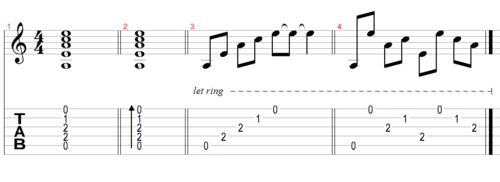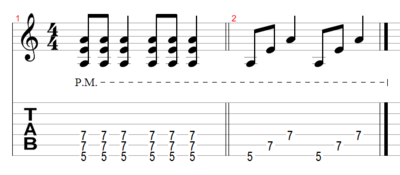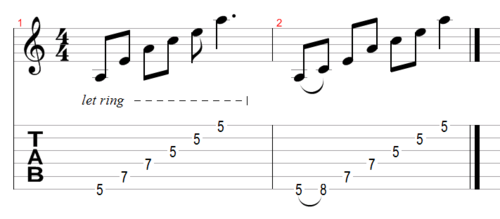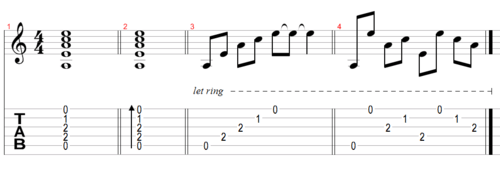There are a number of ways for a guitarist to play a chord that can have a significant impact on how the listener is affected by the song. All of the notes in the chord do not have to be played simultaneously, which is the typical method of playing chords. The term “broken chords” covers various other methods that a guitarist can use to present a chord.
“Arpeggios” are a very similar idea, to the point the two terms are sometimes used interchangeably. Generally, a broken chord lets the notes of the chord ring together, while an arpeggio plays the notes of the chord separately.
Broken Chords
Broken chords are most often used for slower, mellower rhythm guitar work. This is not necessarily the only use of broken chords, but it is the most common usage. There can be a good amount of variance in how slowly the individual notes are introduced. The example below shows three different methods of playing a broken chord, each of which gives a distinctly different tone. Each method uses the exact same open Am chord, but sounds quite different.

Example 1: Standard 'A minor' chord, and three broken chord versions
The first bar is the open Am chord played normally. The notes are played at the same time. The second bar skirts the edge of a normal chord play and a broken chord. The guitarist glides the pick through the strings just slowly enough that each is distinctly played separately. The third bar actually separates each note within the rhythm of the song. Each note is played as a separate eighth note and allowed to ring together to form the full chord. The fourth bar plays a separate note of the chord for each eighth note of the bar. The main difference is the notes are not played sequentially, which creates a different feel than the broken chord in the third bar.
The more sequential broken chord in the third bar is very common in slower rock songs. Aerosmith uses this style of broken chord in a number of slower songs, such as “Seasons of Wither,” “What It Takes,” and “Cryin’.” The Ozzy Osbourne and Lita Ford collaboration “Close Your Eyes Forever,” the Animals version of “House of the Rising Sun,” and “Love Hurts” by Nazareth also are good examples.
The less sequential broken chord in the fourth bar is more common with fingerstyle guitarists. “Landslide” by Fleetwood Mac is a good example of this type of broken chord. Lindsey Buckingham from Fleetwood Mac is well known for his fingerpicking style. Almost any guitarist trained in Travis-style fingerpicking uses patterns similar to the one in the fourth bar of the example.
It is good to get a feeling for how broken chords sound in comparison to a normal chord. Playing the notes sequentially or non-sequentially also has a significant impact on the overall feel of a song using a broken chord. The best choice for a song will usually be fairly subjective.
Broken Power Chords
The same idea of playing a broken chord can also be applied to power chords. The exact same power chord and rhythm sounds quite different when broken up into individual notes. “Smoke on the Water” by Deep Purple uses a broken power chord for most of the rhythm guitar work. The main riff is essentially the only part of the song without one. Iron Maiden’s cover of the Golden Earring song “Kill Me (Ce Soir)” also uses a similar idea. The example below demonstrates how different a broken power chord can sound using the same rhythm as another power chord line.

Example 2: Standard power chord, followed by a broken chord version
Arpeggios
Arpeggios are a slightly different idea from broken chords. The chord tones are played separately, but are not allowed to ring together. A guitarist playing a broken chord will eventually have the notes for the entire chord ringing together. The listener can literally hear the entire chord if the guitarist stops playing at this point. Arpeggios only have one note playing at any given time. The example below demonstrates the audible difference between a broken chord and an arpeggio.

Example 3: Broken Chord vs. Arpeggio
The two look quite similar as guitar tablature or sheet music, but sound quite different. The notes in the broken chord build up to a larger chord. The arpeggio is a straight single note guitar line with no build up to a final chord.
“Walk This Way” by Aerosmith is probably the best known example of an arpeggio being used for a rhythm part. The guitar riff during the verses approximately forms a C7 chord. The actual line does use non-chord tones, but it is a close approximation to the arpeggio.
Arpeggios are more likely to be mixed into lead guitar work. This is especially common with musicians with classical music influences. This creates a slightly different feel than a part written with a full scale would. The next example is a simple arpeggio lead. All of the notes in the entire riff consist of A, C, or E, the notes of the A minor chord.
Further Training
Broken chords and arpeggios are good ideas to practice anytime you learn a new chord. It is also a nice challenge to occasionally try to write an entire lead part with only the notes of a chord. This forces you to avoid using common scale patterns and try new ideas that might seem less obvious. This also helps develop the sound of arpeggios and broken chords as part of your ear training.
Have any tips on listening out for broken chords, or using them in your playing? Leave a note in the comments below!









Thanks very much for this. I'm learning to play bass guitar and this cleared up the difference between chords and arpeggios for me. I wasn't aware of the concept of broken chords, but it makes sense now.
Glad to hear it helped! You might be interested in our Bass Tone series too.